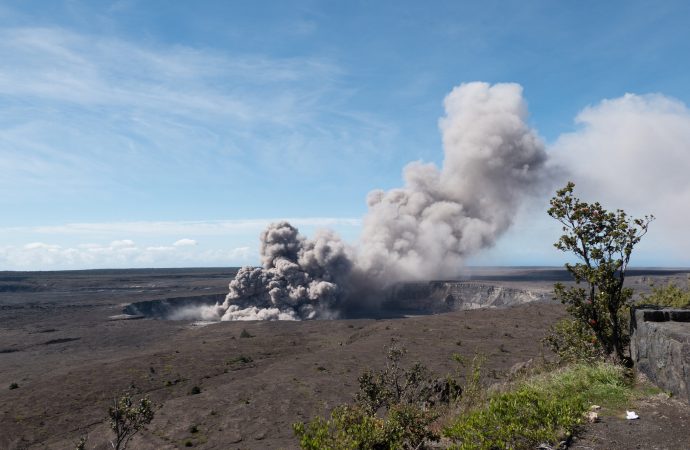Kilauea volcano is spewing lava and belching hazardous gases on Hawaii’s Big Island, forcing more than 1,700 people to evacuate their homes. Eruptions aren’t anything new on Kilauea. In particular, the Pu’u ‘Ō’ō vent, where lava is exposed, has erupted almost continuously since January 1983. But the latest eruption took volcanologists by surprise when it
Kilauea volcano is spewing lava and belching hazardous gases on Hawaii’s Big Island, forcing more than 1,700 people to evacuate their homes.
Eruptions aren’t anything new on Kilauea. In particular, the Pu’u ‘Ō’ō vent, where lava is exposed, has erupted almost continuously since January 1983. But the latest eruption took volcanologists by surprise when it invaded Leilani Estates, a residential area near Kilauea.
Signs of trouble began in mid-March, when increased magma in the system prompted the Pu’u ‘Ō’ō vent to inflate in size, like when a chef pumps cream into a cream puff, Janet Babb, a geologist and Hawaiian Volcano Observatory spokesperson, previously told Live Science. This surge of magma ultimately caused Pu’u ‘Ō’ō’s crater floor to collapse on April 30. After this, the excess magma traveled southeast toward the residential Puna District, Babb said.
Small earthquakes had shaken the region all that week, but residents were taken aback by 5.0- and 6.9-magnitude earthquakes on May 3 and 4, respectively, which preceded lava eruptions. Now, newly opened fissures are bubbling with lava almost daily, and Hawaii County Civil Defense has warned sightseers to stay away for safety’s sake.
Resources for residents
- HawaiiRedCross Twitter page has information on evacuees and available shelters.
- For a list of shelters, evacuation orders, road closings and other information related to the eruption, check out Hawaii News Now.
- Hawaii Civil Defense Messages and Alerts via text and email
- The Hawaii Volcano Observatory has up-to-date photos, alert levels, maps, webcams and other information about the current eruption.
May 16

Credit: U.S Geological Survey
Lava flows escaping from Fissure 17 are slowing down, only advancing about 100 yards (91 meters) in the last 24 hours, according to the Hawaiian Volcano Observatory (HVO). Meanwhile, high levels of volcanic gas are being emitted downwind of the volcanic vents, and trade winds hitting Hawaii today may bring these hazardous gasses to other parts of the island, the HVO said.
At the summit of Kilauea, enormous ash plumes — some reaching as high as 10,000 feet (3,000 m) above sea level — astonished onlookers yesterday (May 15). These plumes came from the Overlook vent, where the lava lake Halema’uma’u sits. It’s likely that rockfall into the lava lake led to these plumes, the HVO said. The ash from these clouds dusted communities from Pahala to Discovery Harbor with ash and made it hazardous to operate aircraft in the area.
The surprises didn’t end there. Two-foot-wide (60 centimeters) ballistic blocks were found in the parking lot, just a few hundred yards from Halema’uma’u.
“These reflect the most energetic explosions yet observed and could reflect the onset of steam-driven explosive activity,” the HVO said. “Additional such explosions are expected and could be more powerful.”
May 15

Credit: U.S Geological Survey
Lava continues to pour from several active fissures. Lava flows crept forward at about 20 yards per hour (0.01 kilometer per hour) from Fissure 17 last night, according to the Hawaiian Volcano Observatory.
Meanwhile, a new fissure opened this morning in the Lanipuna Gardens subdivision, northeast of Fissure 19. And volcanic gas emissions are still high, especially in areas downwind of the volcanic vents. Little earthquakes, many of them magnitude 2 to 4, continue to shake the region as magma roils underground.
At Kilauea’s summit, a plume from the Overlook vent — where the lava lake Halema’uma’u is housed — is “steady and gray” because of volcanic ash, the Hawaiian Volcano Observatory said. This plume is enormous — it’s rising several thousand feet above ground and drifting southeast. Ashfall is already falling down to earth in the upper Ka’u Desert and downwind of the summit.
May 14

Credit: U.S. Geological Survey
There was a stupendous lava show this morning from Fissure 17 (the cracks that have opened up during this eruption are numbered, starting with No. 1), with lava fountaining and explosions of spatter that are being hurled more than 100 feet (30 meters) into the air. Fissure 17 also had lava flowing from it. Meanwhile, Fissure 18, which opened yesterday, is only weakly active now and Fissure 19 is emitting a sluggish lava flow, according to the Hawaii Volcano Observatory.
May 10
Although Pu’u ‘Ō’ō is getting much of the public’s attention, geologists have also been monitoring the lava lake at Kilauea’s summit. This lava lake — called Halema’uma’u — is dropping dramatically, and if it goes below the water table, there could be a steamy and rocky explosion, geologists said.
May 7
A total of 10 volcanic fissures have opened, pouring lava into the residential area of Leilani Estates. Fires from the lava have burned down 35 structures — mostly homes. Volcanic air pollution known as “vog” has prompted authorities to caution that people with breathing problems should stay inside and use air purifiers if needed.
May 4
A magnitude-5.0 earthquake that struck the Big Island on May 3 was followed by lava eruptions that sounded as loud as a jet engine. This prompted mandatory evacuations of the Leilani Estates and Lanipuna Gardens subdivisions.
May 3
More than 600 earthquakes have rattled Hawaii’s Big Island over the past four days as magma from Kilauea volcano moves toward the residential area of Leilani Estates.
Source: Live Science

































Leave a Comment
You must be logged in to post a comment.